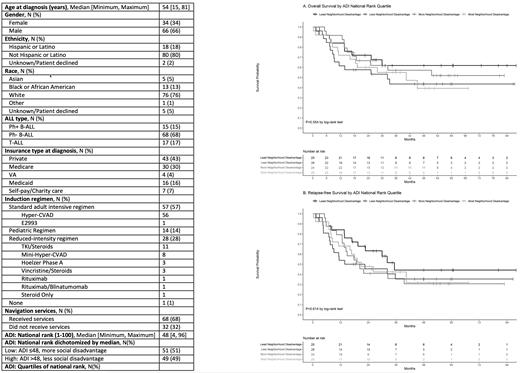Background:
Despite recent advances in therapy (especially in the pediatric population), the treatment of acute lymphoblastic leukemia (ALL) in adult patients remains extremely challenging with only an estimated 30-40% of patients achieving long-term remission. Therefore, it is imperative to identify barriers that may impact delivery of therapy and lead to disparities of outcomes. One area of concern that has been consistently identified is the impact of socioeconomic disparities on the delivery of care. The primary objective of this study is to determine whether increased neighborhood socioeconomic disadvantage as measured by the Area Deprivation Index (ADI) impacts overall survival (OS) in patients with ALL.
Methods:
All patients who presented to the Levine Cancer Institute, a tertiary hospital-based specialty practice, from January 1, 2016 to December 31, 2022 were eligible for inclusion. Patients were included for final analysis if they were aged ≥ 18 years, and had a verified new diagnosis of ALL. All patients received supportive care per institutional standards including nurse navigation, social work, and financial counseling with referral to Financial Toxicity Tumor Board if indicated. Patient demographic, treatment, and disease characteristics were summarized with frequencies (and percentages) or medians (and ranges). Correlation between national and state ADIs were assessed with Spearman's rank correlation coefficient. National and state ADI were analyzed as continuous ranks and as quartile (median for both national and state ADI; quartiles for national ADI). Kaplan-Meier methods were used to summarize OS and estimate landmark survival rates. Cox proportional-hazards models estimated hazard ratios and 95% confidence intervals associated with ADI. Multivariable models with adjustments for clinical covariates included age at diagnosis, risk group, and treatment received (including Oncology Nurse Navigation [ONN] services).
Results:
A total of 100 patients were found to meet criteria for inclusion. Specific characteristics of the analyzed population are listed in Table 1. The population had a median age of 54 years and were primarily treated per three treatment paradigms (standard adult intensive (57%), pediatric-based (14%), and reduced-intensity (28%)). Overall median follow-up (95% CI) was 52.2 months (44.1, 55.5) with a median OS of 51.4 months (25.3 to non-estimable) and median relapse free survival (RFS) of 22.8 months (17.0 to 35.7). When dichotomized by median ADI, there was no significant difference in patient characteristics in the two groups including age, gender, race/ethnicity, ALL type, insurance type, induction regimen, and receipt of ONN services. In univariate modeling, ADI as a continuous variable was not found to be associated with OS (HR 1.01; 95% CI 0.99-1.02, P=0.321) or RFS (HR 1.01; 95% CI 0.99-1.02, P=0.288). This lack of association remained true when dichotomized by median ADI into high and low ADI areas (OS HR 1.01; 95% CI 0.58-1.79, P=0.966; RFS HR 1.17; 95% CI 0.70-1.94, P=0.552), as well as by splitting ADI into quartiles (Figure 1). A multivariate model including age at diagnosis, ALL type, ONN services received, and treatment regimen similarly showed no association between ADI and OS (p=0.221) and RFS (p=0.453). Of particular interest is the high extent of navigation services received in this population (62.8% of patients in areas of less disadvantage, and 73.5% of patients from areas of higher disadvantage). Patients who received navigation services also appeared to be a higher risk population, as multi-variable modeling confirmed both decreased OS (HR 2.11; 95% CI 1.12-4.00, P=0.023) and RFS (HR 2.08; 95% CI 1.17-3.71, P=0.012) when compared to those who were not deemed by the nurse navigators to need this service.
Conclusions:
Contrary to larger database derived studies, patients with ALL treated at our center did not show differences in OS or RFS when compared by neighborhood disadvantage. This is likely a consequence of the strong support systems available at this institution in nurse navigation and financial toxicity related programs which help mitigate some of the risk factors for disparate outcomes. These findings should be validated in a larger cohort with prospective data with a particular focus on designing sustainable and realistic options to be utilized at community-based and underserved systems.
Disclosures
Chojecki:Research to Practice: Consultancy; incyte: Research Funding; CTI Biopharma: Membership on an entity's Board of Directors or advisory committees; Morphosys: Consultancy, Membership on an entity's Board of Directors or advisory committees; Novartis: Consultancy, Membership on an entity's Board of Directors or advisory committees; Servier Pharmaceuticals: Membership on an entity's Board of Directors or advisory committees. Grunwald:Incyte Corporation, Janssen: Research Funding; Medtronic: Current equity holder in publicly-traded company; Karius, Novartis, Ono Pharmaceutical, Pfizer, Pharmacosmos, Premier, Stemline Therapeutics: Consultancy; AbbVie, Agios/Servier, Amgen, Astellas Pharma, Blueprint Medicines, Bristol Myers Squibb, Cardinal Health, CTI BioPharma/Sobi, Daiichi Sankyo, Gamida Cell, Genentech, Gilead Sciences, GSK/Sierra Oncology, Incyte Corporation, Invitae, Jazz Pharmaceuticals: Consultancy. Ragon:Astellas: Other: Advisory board; Pfizer: Other: Advisory board; Genentech: Other: Advisory Board.


This feature is available to Subscribers Only
Sign In or Create an Account Close Modal